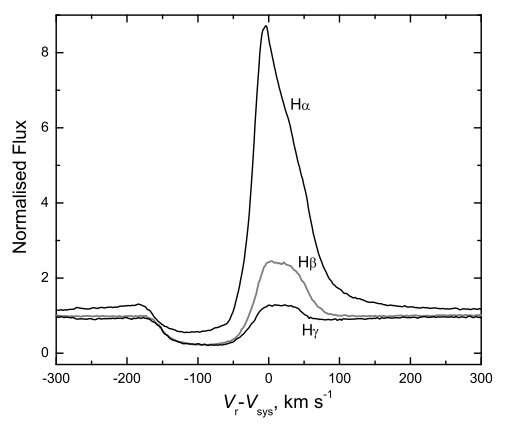December 9, 2019 report
IRAS 18379–1707 is a metal-poor high-velocity star, observations find

Astronomers have conducted high-resolution spectroscopic observations of IRAS 18379–1707 (or LS 5112), a candidate post-asymptotic giant branch (post-AGB) star in the Milky Way galaxy. Results of the observations provide more details about the properties of this object, revealing that it is a metal-poor, high-velocity star. The findings are detailed in a paper published November 28 on arXiv.org.
Post-AGB phase is one of the least understood phases of the evolution of low- and intermediate-mass stars. It is a short-lived but important stage that such stars go through when evolving from AGB to become planetary nebulae (PNe). In order to better understand this phase, astronomers are searching for new post-AGB stars to characterize them in detail.
LS 5112 was first described in 1971 in the Catalog of Luminous stars in the Southern Milky Way and was later identified with the infrared source IRAS 18379–1707 from a catalog of possible planetary nebulae published in 1988. Subsequent observations classified this source as a hot post-AGB candidate.
To date, only low-resolution optical spectroscopic studies of IRAS 18379–1707 have been carried out, hence the nature of this object remains poorly understood. With the aim of changing this, a group of astronomers led by Natalia Ikonnikova of Lomonosov Moscow State University, Russia, have performed high-resolution spectroscopic observations of this source using the Fiber-fed Extended Range Optical Spectrograph (FEROS) on the MPG/ESO 2.2-m telescope at La Silla Observatory in Chile. FEROS allowed them to get important insights into the parameters and chemical composition of the studied object.
"In this paper, we report an analysis of the high-resolution spectrum, on the basis of which the chemical composition was obtained for the first time and the fundamental parameters of the star with the best accuracy at the moment were determined," the astronomers wrote in the paper.
The research found that IRAS 18379–1707 has an effective temperature and a heliocentric radial velocity of approximately -124 km/s. The star's core mass was estimated to be about 0.58 solar masses, while the mass of its progenitor was calculated to be nearly three times greater. The object was measured to be located some 10,560 away from the Earth and about 14,670 light years away from the center of our galaxy.
When it comes to chemical composition of IRAS 18379–1707, the study found that the total abundance of metal to hydrogen ratio [M/H] is approximately -0.6 and that some elements like oxygen, carbon and nitrogen are slightly overabundant relative to sulfur. This, according to the researchers, suggests that the products of helium burning have come to the surface as a result of third dredge-up on the AGB.
Moreover, the research detected permitted and forbidden emission lines of several elements in the spectrum of IRAS 18379–1707, indicative of the presence of a low excitation nebula around the star and an ongoing post-AGB mass loss. The observations also found that the object displays a brightness variation on a scale of a few nights with a maximum amplitude of up to 0.2 mag in the V-band.
Summing up the results, the authors of the paper concluded that IRAS 18379–1707 is a hot, metal-poor post-AGB star with a relatively low mass and high velocity. Trying to explain the observed photometric variability, the astronomers assume that it is associated with a variable stellar wind. However, they do not exclude other causes of this variability and propose further observations of IRAS 18379–1707 in order to find the most plausible hypothesis.
More information: High-resolution spectroscopy of the high velocity hot post-AGB star IRAS 18379-1707 (LS 5112), arXiv:1911.12636 [astro-ph.SR] arxiv.org/abs/1911.12636
© 2019 Science X Network





















